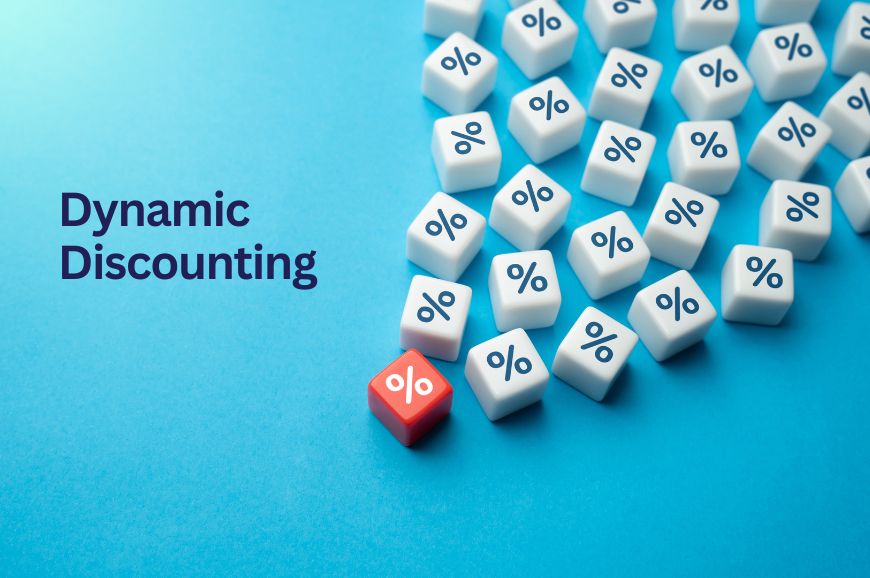Every business knows that managing cash flow effectively is crucial, not just for survival but for long-term growth. This challenge becomes even more pressing when dealing with multiple suppliers, each with its own payment terms and timelines. Traditionally, companies have relied on standard payment terms, which often lock both suppliers and buyers into rigid schedules that don’t always align with their financial needs. But recently, a more flexible approach has started to make waves—dynamic discounting.
Dynamic discounting is a strategy that’s gaining real traction in the business world. Unlike the old one-size-fits-all payment terms, dynamic discounting offers a tailored solution where buyers can pay their suppliers earlier than agreed upon in exchange for a discount. This might sound straightforward, but the implications for both parties involved might be significant. For suppliers, it means faster access to cash, reducing their reliance on expensive credit lines or loans. For buyers, it translates to cost savings and stronger relationships with their supply chain partners.
Dynamic discounting is shown to be a useful strategy for keeping cash on both sides of the table as businesses deal with fluctuating economic conditions and an ongoing need to operate more effectively. But, why is this strategy becoming more and more popular, and how can businesses benefit from it? This article will explain dynamic discounting, look at why it’s catching on, and discuss the advantages it provides to both buyers and suppliers.
What is dynamic discounting?
Dynamic discounting is a flexible payment arrangement that allows buyers to pay their suppliers earlier than the agreed payment terms in exchange for a discount on the invoice. Unlike traditional payment terms, which are fixed and often rigid, dynamic discounting gives both parties more control over when payments are made and received.
For suppliers, this means quicker access to funds without having to wait for the typical 30, 60, or 90-day payment cycles. It’s especially useful for suppliers who need cash flow to manage their operations more efficiently or invest in growth. For buyers, it offers a straightforward way to reduce costs by taking advantage of early payment discounts, which can accumulate into significant savings over time.
In traditional trade credit, payment terms like 2/10 Net 30 are common. This means that buyers can take a 2% discount on the invoice amount if they pay within 10 days; otherwise, the full invoice amount is due in 30 days. While this offers some incentive for early payment, it is not flexible—buyers must decide whether to pay early for the discount or wait for the full term.
On the other hand, dynamic discounting isn’t a one-size-fits-all solution; it’s adaptable. The discount rate can vary depending on how early the payment is made, allowing both parties to negotiate terms that best fit their financial needs. This flexibility is what makes dynamic discounting so appealing in every business environment—it’s not just about meeting payment deadlines, but optimising cash flow and strengthening partnerships along the way.
What is the difference between dynamic discounting and factoring?
With dynamic discounting, the buyer offers to pay the supplier early in exchange for a discount on the invoice. This is a direct agreement between the buyer and the supplier, without involving any third parties. The supplier receives the payment early, and the buyer saves money through the discount. The flexibility of dynamic discounting lies in its ability to let both parties negotiate the discount based on how early the payment is made.
On the other hand, factoring involves a third party—usually a financial institution or factoring company. In factoring, the supplier sells their outstanding invoices to the third party who then collects the full payment from the buyer when the invoice is due. Although both strategies are a great way for faster collection of receivables, the main difference is that dynamic discounting does not involve a third party.
What is the difference between dynamic discounting and reverse factoring?
While both dynamic discounting and reverse factoring (also known as supply chain finance) allow suppliers to receive early payments, the key difference lies in how the payment is funded and the parties involved.
As we mentioned in the previous segment in dynamic discounting, the buyer funds the early payment directly. The buyer offers to pay the supplier earlier than the agreed-upon payment terms in exchange for a discount on the invoice. The arrangement is entirely between the buyer and supplier, giving them flexibility to negotiate the timing and discount.
When it comes to reverse factoring, a third party—usually a financial company or an institution—is prompted by the buyer in order to pay the supplier early. The buyer approves the supplier’s invoice, and the third party pays the supplier. The supplier then can receive early payment minus a small fee or collect the whole sum on the invoice’s due date. The buyer then pays the financial institution at a later date. Therefore, the buyer typically doesn’t bear any costs.
Benefits for suppliers
- Improving cash flow at a lower cost
- Better management of day-to-day activities
- Quick access to funds
- Fosters sense of trust and reliability
For suppliers, dynamic discounting provides a valuable opportunity to improve cash flow without relying on costly financing options. Traditional methods like taking out loans or using lines of credit can carry high interest rates, adding pressure to already tight margins. Dynamic discounting, however, offers a way to access funds quickly and at a lower cost by simply agreeing to a slight reduction in the invoice amount.
With faster access to cash, suppliers can better manage their day-to-day operations, pay their own bills on time, and even invest in growth opportunities. This can lead to greater financial stability and reduce the stress of waiting for long payment terms like 30, 60, 90, or sometimes even 120 days. The flexibility of dynamic discounting means suppliers can choose when to take advantage of early payments based on their current cash flow needs.
Moreover, dynamic discounting strengthens the relationship between suppliers and buyers. When suppliers have access to reliable cash flow, they’re in a better position to meet the demands of buyers, fulfill orders on time, and maintain high levels of service. In turn, this fosters a sense of trust and reliability that can benefit both parties in the long term.
Benefits for buyers
- Cost savings
- Flexibility
- Build strong relationships with suppliers
- Support internal financial planning
Dynamic discounting doesn’t just help suppliers—it can offer significant advantages for buyers too. One of the most immediate benefits is cost savings. By paying suppliers early in exchange for a discount, buyers can reduce their overall procurement costs. Over time, these savings can add up, especially for companies with large or frequent purchases.
Unlike traditional payment terms, dynamic discounting provides flexibility, allowing buyers to decide when to take advantage of these discounts based on their own cash flow situation.
Additionally, paying suppliers early can help buyers build stronger, more reliable relationships with their supply chain partners. Suppliers appreciate the prompt payment and are more likely to prioritize buyers who consistently provide faster access to cash. This can lead to better service, more favorable terms in future negotiations, and even preferential treatment when it comes to order fulfillment or product availability.
Finally, dynamic discounting can support a buyer’s internal financial planning. By managing payments more strategically, buyers can improve their working capital management and create a smoother cash flow cycle. It offers a way to optimize finances without sacrificing liquidity or stretching budgets, making it an appealing option for companies focused on efficiency and long-term partnerships.
The role of technology in dynamic discounting

Do you find this article interesting?
Subscribe to our Newsletter for updates on the latest blog articles.
Technology plays a crucial role in enabling dynamic discounting. Without the right tools, managing early payments, calculating discounts, and coordinating with multiple suppliers would be complex and time-consuming. Today, digital platforms and software solutions have streamlined the process, making it easier for both buyers and suppliers to implement dynamic discounting seamlessly.
Many companies now use automated systems that integrate with their existing financial infrastructure, allowing real-time visibility into invoices and payment options.
These platforms can automatically calculate discount rates based on how early payments are made, and suppliers can choose to accept or decline offers with a few clicks.
This kind of automation not only saves time but also reduces the risk of human error in calculating terms and managing payments.
Beyond simple automation, advanced analytics help companies track and optimize their use of dynamic discounting. By analyzing payment trends, buyers can identify opportunities to save more, while suppliers can better forecast their cash flow needs.
According to a study published by McKinsey & Company, the total value of assets financed in the trade and supply chain finance market stands at $7.3 trillion. The key segments within this landscape include documentary business, seller-side finance, and buyer-led SCF, which includes reverse factoring and dynamic discounting.
Documentary business, with $3.8 trillion in assets financed, remains a staple in traditional trade finance, growing modestly at 1-2% CAGR. This model largely relies on banks processing transaction-related shipping documents to ensure smooth cross-border trade. Similarly, seller-side finance, valued at $3 trillion, focuses on receivables financing, where sellers borrow against outstanding invoices, growing at a slightly faster rate of 3-5% CAGR.
What catches the eye is that the buyer-led solutions like reverse factoring and dynamic discounting are the fastest-growing segments, reflecting a shift towards more buyer-driven financing models. These segments have higher compound annual growth rates (CAGR), ranging from 15-30%, which significantly outpaces traditional documentary business and seller-side finance.
Reverse Factoring:
- Assets Financed: $0.4 trillion
- CAGR (2019-2024): 15-20%
Dynamic Discounting:
- Assets Financed: $0.1 trillion
- CAGR (2019-2024): 25-30%
Key takeaways:
The growth of reverse factoring and dynamic discounting underscores the increasing role of fintech and digital platforms in facilitating SCF transactions. Platforms help bridge the gap between buyers and sellers, enabling smoother and more transparent financing processes.
Additionally, the shift towards buyer-led solutions shows how buyers are taking a more active role in the supply chain financing process, potentially improving liquidity and cash flow for both buyers and suppliers.
Although, traditional models will continue to play a significant role, the rapid growth of dynamic and reverse financing points to an evolving landscape where digital platforms and buyer involvement are key factors.
The bottom line
While dynamic discounting offers clear benefits, it’s not without its challenges. One of the primary considerations is whether both parties—buyers and suppliers—are ready to integrate dynamic discounting into their existing financial processes.
As we have discussed earlier, implementing this strategy requires technological investment, and for companies that rely on manual processes, transitioning to an automated system can be a little bit overwhelming. This includes training staff, upgrading software, and ensuring that both sides of the transaction have compatible systems in place.
For suppliers, a key challenge can be balancing the need for cash flow with the potential loss of revenue due to offering discounts. While early payment will definitely provide liquidity, it also will reduce the total income from the invoice. This area is where the suppliers need to evaluate whether the benefits of immediate cash outweigh the smaller profit margin.
On the other side of the coin, buyers must think about their own cash flow situation to ensure they’re in a position to consistently take advantage of early payment discounts without straining their liquidity.
Another consideration is communication and transparency. Both parties need to have clear terms set from the beginning, understanding when and how payments will be made, and how discounts will be applied. Without proper coordination, misunderstandings can occur, leading to an increased friction between buyers and suppliers. So the key to long-term success is having a well-established process and open dialogue.
At the end of the day, dynamic discounting isn’t always going to be the right fit for every supplier or buyer. Smaller businesses or those with tight margins may find the discounts too costly or even difficult to manage. That is why, it’s important for each company to evaluate their unique financial situation before fully adopting the system.








